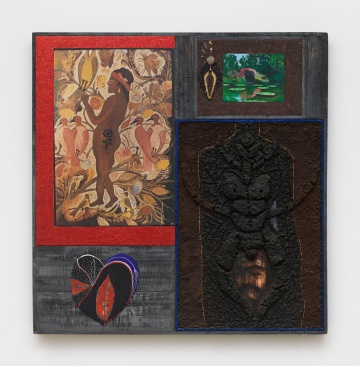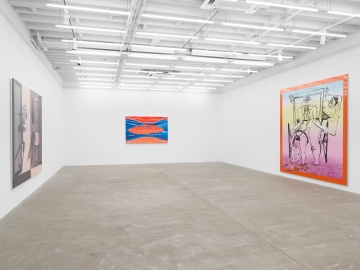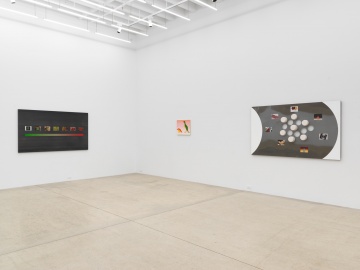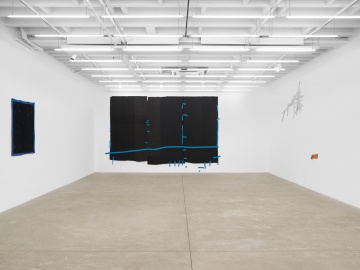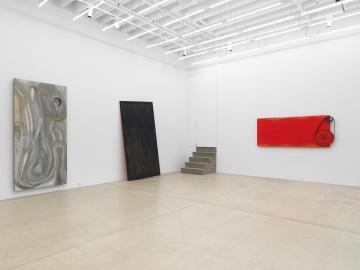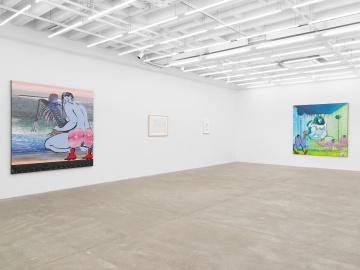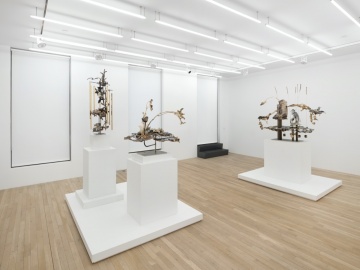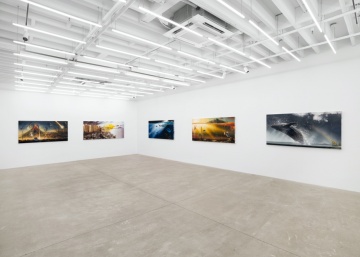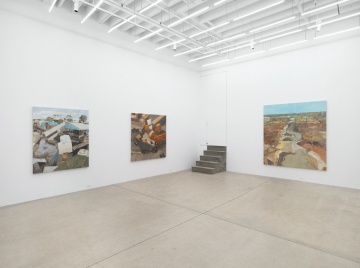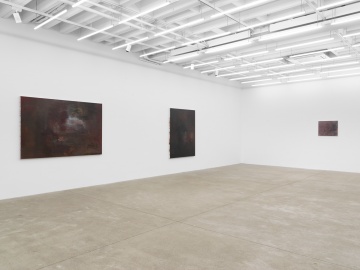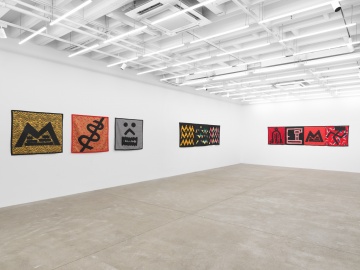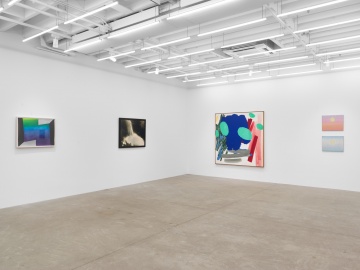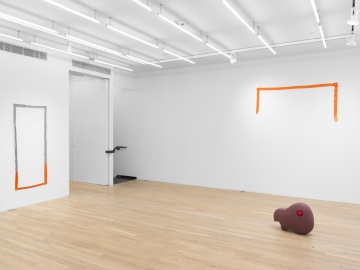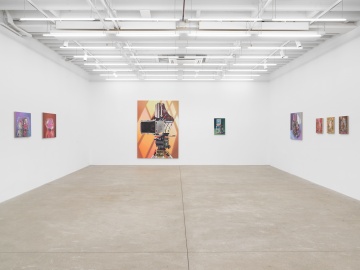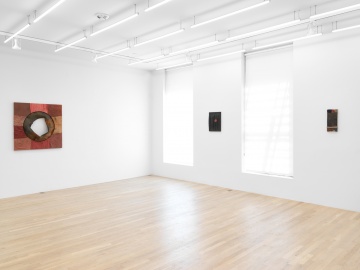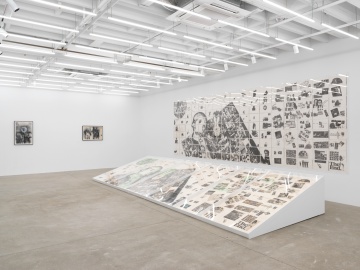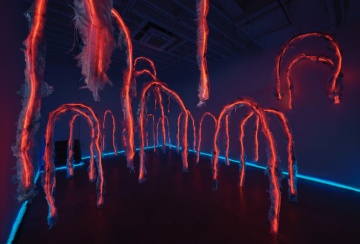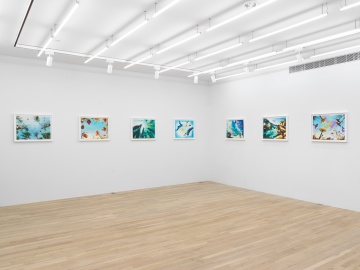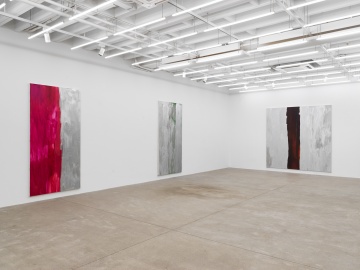Magenta Plains
149 Canal Street
New York, NY 10002
917 388 2464
New York, NY 10002
917 388 2464
Magenta Plains was founded in the Lower East Side in 2016 and relocated to a multi-floor, 4,500 square-foot space at the intersection of Canal Street and Bowery in 2022. With an intergenerational emphasis, the gallery's mission is to foster context and meaning for the development of new ideas and emerging art as well as to exhibit and preserve older generations of artists' work. The gallery has organized more than 65 exhibitions and presents a dynamic discourse through curated group shows and programming across a multitude of disciplines.
The gallery represents artists including Jennifer Bolande, Ebecho Muslimova, Rachel Rossin, Ken Lum, Zach Bruder, Don Dudley, the Estate of Barbara Ess, Tiril Hasselknippe, Jibade-Khalil Huffman, Alex Kwartler, Liza Lacroix, Matt Keegan, Anne Libby, Chason Matthams, Peter Nagy, Bill Saylor, Jane Swavely, and the Stan VanDerBeek Archive. Additionally, the gallery presents a dynamic discourse through its program of curated group shows and project-based solo exhibitions including Sascha Braunig, Danica Lundy, Daniel Boccato, David Ostrowski, Matthew Metzger, Alexis Rockman, and Alan Uglow.
Magenta Plains has presented memorable historical solo exhibitions including William Wegman’s rare, altered photographs and drawings from the 1970s and 80s, Lillian Schwartz’ critically acclaimed debut New York solo gallery show at age 89, German artist Georg Herold’s caviar paintings and sculptures, a critically acclaimed exhibition of paintings from the 1980s by Martha Diamond, an exhibition of Tina Girouard's rarely exhibited "DNA-Icons" series, and new found object sculptures by Jon Kessler. The gallery also looks forward to upcoming presentations of works by Moira Dryer and Paul Gardère.
Artists Represented:
Alex Kwartler
Alex Kwartler
Anne Libby
Estate of Barbara Ess
Bill Saylor
Chason Matthams
Don Dudley
Ebecho Muslimova
Jane Swavely
Jennifer Bolande
Jibade-Khalil Huffman
Ken Lum
Liza Lacroix
Matt Keegan
Peter Nagy
Rachel Rossin
Stan VanDerBeek Archive
Tiril Hasselknippe
Zach Bruder
Works Available By:
Alexis Rockman
Alexis Rockman
Jon Kessler
Matthew Metzger
Monsieur Zohore
Sascha Braunig
Tina Girouard
William Wegman
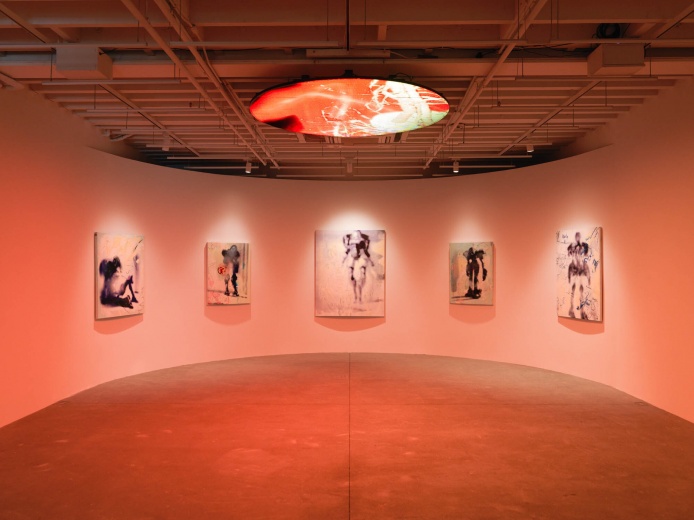

Installation view of Rachel Rossin: SCRY, at Magenta Plains, 2023.
Installation view of Stan VanDerBeek: Transmissions, at Magenta Plains, 2024.
Paul Gardère
Second Nature
September 12, 2025 - October 25, 2025
Magenta Plains is pleased to present Paul Gardère: Second Nature, a solo exhibition of rarely exhibited mixed media paintings from 1994-2000 by Haitian born, American artist Paul Gardère. Combining acrylic painting, relief sculpture, photography, found object assemblage, mud, and collage, these works encapsulate a pivotal moment in the life and practice of Gardère. This period saw his lifelong inquiries into social, economic, and racial dynamics of power and identity crystallize into a singular vision. Born in 1944, the artist’s work sits at the intersection of critical strands of 20th century art history: the visual and cultural legacy of the Afro-Caribbean diaspora in the Americas, the legacies of Impressionism and Early Modernism in the former French colonies of the Caribbean, and the interweaving of these themes with the dynamism of mid-century painting in New York. This focused exhibition comes on the heels of a critical survey recently held at the Stuyvesant Fish House at The Cooper Union, the artist’s alma mater, in New York.
Sascha Braunig, Melissa Brown, Becky Kolsrud, Danica Lundy, Josephine Meckseper, Ebecho Muslimova, Julia Wachtel
Resistance & Reimagination
July 3, 2025 - August 15, 2025
Resistance & Reimagination brings together seven exceptional painters who understand the subtle, often invisible modes of resistance that reside within the structures of visual language, challenging us to reconsider the role of image-making—not only in political discourse but in everyday acts of selfexpression. Through the work of Sascha Braunig, Melissa Brown, Becky Kolsrud, Danica Lundy, Josephine Meckseper, Ebecho Muslimova, and Julia Wachtel, this exhibition explores how contemporary painting, at times infused with the playful intensity of graphic and animated forms, becomes a tool for reflection and reinvention.
Matt Keegan
Realia
May 7, 2025 - June 21, 2025
Magenta Plains is pleased to present Matt Keegan’s first solo exhibition with the gallery titled Realia, an exhibition of new paintings and mixed media sculpture. This presentation builds upon a body of work made from an archive of hundreds of English language-teaching flashcards handmade by his mother, a first-generation Cuban American and ESL (English as a second language) teacher. Mainly assembled throughout the 1990s from mass-market print materials such as clothing catalogues, magazines, union mailers, and other printed matter from within his family home, the cards were used in her classroom to introduce newly emigrated students to the English language via photos predominantly used for advertising. Keegan has appropriated this image archive for his work since 2010 to investigate the relationship between the medium of photography, the structure of language expression, and to probe how a photographic image can produce meaning.
Hana Miletić
Desire Lines
May 6, 2025 - June 21, 2025
Magenta Plains is pleased to present Desire Lines, an exhibition of new hand-woven textile works by Hana Miletić. For her first gallery exhibition in the U.S., Miletić builds upon her well-known Materials series (ongoing since 2015). In the Materials series, delicate, often brightly colored weavings are conceived in relation to street photography, and hand woven on a 1970s loom. Extending from her formal training as a photographer, their idiosyncratic shapes and color-schemes are based on Miletić’s snapshots of temporary repairs to buildings and objects in urban public spaces. For Desire Lines, most of the works draw from the gallery’s neighborhood, New York City’s Chinatown. After photographing specific repairs and transformations during a site visit in 2024, the artist hand-wove each piece on her studio loom in Brussels. Reflecting on the incommensurable relationship between representation and historical development, Miletić’s process slows down production, translating overlooked, ad hoc handiwork in public space into delicate textile forms.
Moira Dryer
Perpetual Painting
March 13, 2025 - April 26, 2025
Moira Dryer: Perpetual Painting March 13–April 26, 2025
Lower Level and Level Two
Magenta Plains is pleased to present Moira Dryer: Perpetual Painting, a posthumous solo exhibition of works from 1986 to 1992. So many conversations about Moira Dryer’s work center around the lasting relevance of painting, her painting. Peers, gallerists, curators, collectors, family, and friends who knew her personally during her brief life speak of her today with the same deep love and admiration, with a little smirk for her playful rebellion, as if she will walk in the room to say hello at any moment.
Both The Perpetual Painting (1988) and The Ghost and The Machine (1987) wink at this idea of longevity. Titles were an important part of Dryer’s practiced thinking and as many pages in her studio notebooks were taken over with found language collages and lists of possible titles. With an almost engrained sensitivity for the fragility of life, the artist supports the idea of the mind-body duality now colloquially and patronizingly referred to as “the ghost in the machine.” Pushing this just a bit further, as she actively pushed the paint in large loose waves over the surface of the panel, she titled the work, “the ghost and the machine,” clarifying that the two indeed coexist, asserting their autonomy. The wheel and arm imbedded in the top corner of the panel remember the life of the painter—the physicality of the stretched arms, the rotation of the heavy panel that created drips now running parallel to the floor in a ghostly defiance of gravity—who now is separated from the physical body at indefinite rest.
Painting has died a thousand deaths. To paint, especially when Dryer was hard at work, when conceptualism and expressionism were fiercely locked in debate, Dryer applied the idea of the ghost in the machine more broadly—conceptualism and expressionism were the mind-body duality that appears in all her work. She presented The Perpetual Painting as a conceptual double entendre asserting the endurance painting as if an infinite wave or a pulley system with an endless belt.
Dryer’s work was serious. She was addressing real topics of art history and of her time. She was a great lover of Renaissance art and mathematics, decoration, and language, among so many other relevant interests. She also had a wry sense of humor. She poked holes, literally and figuratively, in the cohesive surfaces and images of her work, as in Untitled (1992); she gave cultural meaning and aesthetic value to mathematical concepts like shock in Culture Shock (1990) and many of the drawings on view; and she poked fun at the idea of the artist’s hand in the work by representing fingerprint whorls (The Fingerprint, 1987) and thumbprints impeding on the face of the painting as if to assert their hand (Untitled, 1990).
It is because of this deep commitment to thought and expression that Moira Dryer continues to feel ever-present and prescient. By approaching her paintings with plurality, they will forever be relevant and alive. –Lily Siegel
Ebecho Muslimova & Maria Lassnig
March 13, 2025 - April 26, 2025
Ebecho Muslimova & Maria Lassnig March 13–April 26, 2025
Level One
Magenta Plains is pleased to present Ebecho Muslimova & Maria Lassnig, an exhibition that brings together the work of two artists who confront the psychological and physical experience of the body in profoundly individual yet resonant ways. New paintings and sumi ink drawings by Muslimova are paired with historic works by Lassnig dated from 1970-1992.
While stylistically distinct, the practices of Lassnig and Muslimova converge on the theme of bodily perception as a site of self-exploration. This exhibition juxtaposes Lassnig’s intense, gestural paintings and expressive watercolors with Muslimova’s line-based, cartoon-like works. Both artists share a commitment to vulnerability; Lassnig confronts embarrassment, as seen in her deeply personal works that chronicle her fears and emotions on canvas. Muslimova, in a similar vein, exposes the awkward and often absurd nature of the body and its impulses. The two thus navigate the delicate balance between self-protection and self-exposure, presenting the female body as a vessel of truth, humor, and unfiltered emotional honesty.
“Fatebe,” Muslimova’s recurrent protagonist, embodies a catalog of human experience with a raw, almost grotesque sense of acceptance. Fatebe’s surrealistic, exaggerated gestures and poses capture a vast spectrum of emotions, from resilience to absurdity, mirroring Lassnig’s Körperbewusstseinsmalerei or “body-awareness painting” approach, in which Lassnig painted her bodily sensations and subjective feelings rather than physical appearances. Just as Lassnig’s works translate internal sensations — like pressure, tension, and discomfort — into compositions that defy traditional figuration, Muslimova’s Fatebe navigates the tensions of personal identity, often pushing against the limits of social norms and expectations of femininity.
Muslimova’s new works explore Fatebe’s relationship to the concept of “l’homme différent,” a term coined by historian Lucian Boia which describes a popular trope in science fiction in which humans encounter human-adjacent entities, such as Mary Shelley’s Frankenstein or Hans Christian Andersen’s The Little Mermaid. In these tales, the non-human entity is used as a mirror of an anxiety in the human condition, most often aligned with a concern about technological or sociocultural advancement. Fatebe functions similarly; her body is stretched, manipulated, hybridized, and otherwise altered to the threshold of unrecognizability, while maintaining a tenuous relationship to the human form. For example, in Fatebe Io Stalled (2024), Fatebe herself appears in a reprisal of the myth of Io, lover of Zeus, who was turned into a heifer by the Greek god to avoid detection by his wife Hera. In the image, Fatebe wears a mask which situates her mid-transformation, and is a hybridized version of herself, fused with the bathtub, while surrounded by distinct Fatebes creating an audience for this Greek tragedy. To her right is another hybrid Fatebe, this time with an ancient Greek “rhyton,” a drinking vessel designed to only be set down once it is emptied–as is the bathtub with which Fatebe/Io is morphed. The system is cyclical, uncanny, and it is clear that we have encountered this transformation at a midway point. Fatebe then embodies the anxiety spawned amidst technological upheaval, akin to Boia’s “l’homme different.”
Each work on view by Lassnig represents a different dimension of her practice: small-scale gestural drawing, figurative self-portrait, and pseudo-abstraction. Zornige Schreckschraube (Angry Shrew/Screw) (1992) offers an apt comparison to Muslimova’s work–the wordplay of the title illuminates the painted object as a biomechanical representation of feminine anger. The screw head is overtly clear, but it is connected to a coiled, pinkish, fleshy form which evokes an intestine as much as a cobra. Lassnig utilizes this creature as a metaphor for the way in which feminine anger is diminished, and aspects of the feminine are othered as non-human. The stories of Fatebe/Io and the Angry Screw/Shrew are, if not directly related, certainly thematically aligned.
This exhibition invites viewers to witness the evolution of female self-representation across generations, encouraging a conversation about the ways women artists have used their bodies as both subject and medium. Through this, Muslimova and Lassnig not only depict the body but turn it into a map of lived experience, inviting us to see through their eyes and feel through their skin.
Jon Kessler
Petrified
January 16, 2025 - March 1, 2025
Magenta Plains is pleased to present Petrified, a selection of bronze and ceramic sculptures from a brand new, never-before exhibited body of work by Jon Kessler. The three freestanding works utilize upcycled bronze spills while incorporating materials as varied as scavenged metal, glazed clay, and German porcelain figurines. The result is a series of whimsical constructions that speak to contemporary anxieties around climate and ecology while simultaneously evoking an alternative world of wonder.
The sculptures in Petrified draw on multiple influences, notably Alexander Calder’s “stabiles” and Japanese ikebana flower arrangements. In addition to their dynamic compositions, the sculptures imply movement or are otherwise kinetic. Small counterweights, polished chime-like rods, or cattails wrought from brass fluidly react to a viewer's presence in the room. For example, in Scorched Earth II (2024), elements pierce a piece of metal polished to a mirror sheen, giving the impression of the surface of water. Above, extruded glazed stoneware resembles driftwood, while porcelain figurines of herons perch on its surface. A small porcelain lamb sits nestled in the folds of a shattered iPad.
Kessler’s work has long straddled the boundary between speaking to modern anxieties and actively eliciting them in the viewer. Past projects have dealt with war, terrorism, surveillance, the military industrial complex and global warming, often in confrontation and always intended to provoke powerful reactions from the viewer. In Petrified, Kessler has moved away from these aggressively confrontational works toward more subtle and mournful evocations of ecological fragility.
Utilizing many familiar tropes of the 20th century artist: the assemblage, the found object, the political affect–Kessler has opted for a series of surprisingly intimate and considered constructions. Expanding on his recent explorations in bronze and ceramics, these works conjure post-pastoral landscapes, where beauty and ecological collapse intertwine. Combining industrial debris, the residue of kitsch, and repurposed pieces of technology, these relics of the future balance elegance and entropy, offering a poignant commentary on reclamation and regeneration.
Alexis Rockman
Naples: Course of Empire
January 16, 2025 - March 1, 2025
Magenta Plains presents Naples: Course of Empire, a series of seven new paintings by Alexis Rockman. Rendered in Rockman’s signature style of history painting, these oil on panel works each display a stage in the life cycle of Naples, Italy and its relationship to the natural environment from the Cretaceous Period to a likely future post-climate disaster. Taking one of Europe’s greatest coastal cities as a site for the first time, Rockman provides an example for other shore-side towns at risk due to higher global temperatures. The exhibition will travel to Fondazione Morra Greco in Naples, Italy, to be on view in Spring 2025.
Alexis Rockman’s work addresses the sustainability of human consumption and our imperative to protect the natural world from pollution, introduced species, genetically-modified organisms, climate change and other man-made disruptions. In Naples: Course of Empire, Rockman mixes his signature realism with more abstract brushstrokes and visibly painted surfaces, evoking the chaos and tumult of Naples’ past and history foretold. Referencing Thomas Cole’s seminal cycle The Course of Empire (1833-36), this cycle of paintings seeks to locate the ecological footprint of human settlement of Naples and its impact on the local flora and fauna. It does so with an eye toward a dystopic future which seems ever more likely as the international community postpones a genuine, coordinated effort to fight climate change.
An Ichthyosaur, a dinosaur, and flowering plants endemic to the area around Naples 200 million years ago are washed up on the beach under a cycad tree in The Fossil Record: Tethys Sea. In Grotte di Pertosa, human beings enter this tale, as he represents a romance between a neanderthal and a modern human in a natural cave destined to become one of Naples’ notable tourist attractions. Rockman’s painting Mt. Vesuvius, Autumn, 79 AD represents perhaps the most famous natural disaster in history: the volcanic eruption which buried the ancient Roman towns Pompeii and Herculaneum—seen from the perspective of the local fauna. In Plague in the Kingdom of Naples, 1656-1658 inhabitants of the city suffer at the hands of the Bubonic plague, spread by an airborne avatar of Death. In The Departed, Rockman visualizes the epidemic of overfishing in the Mediterranean, with species that have suffered below the waterline and a historical progression of fishing vessels above. This work is inspired by the structure of a trophic web or food chain, depicting how nutrients move across ecosystems in the forms of plants and animals. In Acquario di Napoli - Stazione Zoologica Anton Dohrn, Rockman illustrates the Neopolitan city aquarium in ruin underneath 70 meters of sea water, the very possible result of climate change. The Gulf of Naples as we know it will not survive catastrophic sea level rise, and in this painting we see its uncertain future: submerged and inhabited by invasive species such as lionfish, reticulated leather jacket, and big-fin reef squid. Finally, in Post Human: Palazzo Donn’Anna Rockman shows a whale breaching and overjoyed, celebrating the extinction of humanity in front of the ruins of one of the most recognizable buildings on the Neapolitan coast.
In the past, Rockman has addressed the impact of introduced plant and animal species on wetland ecosystems in Louisiana, presented a vision of the Brooklyn waterfront submerged beneath the sea due to the effects of global warming, imagined drinking water from the Gowanus Canal—one of the most polluted bodies of water in the world, envisioned a farm filled with genetically-modified organisms to ask what role should ethics play in research and experiments, examined the intertwined natural and human histories of the Great Lakes, and depicted a collection of extinct species, including the iconic dodo. In tandem with these paintings, Rockman has also executed a series of Field Drawings, which represent the various native animals and plants to Campania and the area around the city, made from stones and earth collected from the slopes of Mount Vesuvius. Contrary to the narrative structure of the painting cycle, these drawings serve as a small sampling of the wilderness inherent to the land on which Naples is situated. Collectively, the paintings and drawings which comprise Naples: Course of Empire demonstrate the ways in which nature responds to our interventions, and how they impact the other species with which we share the world.
Rexy Tseng
Mouthful of Dirty Copper
January 16, 2025 - March 1, 2025
Painting has survived successive revolutions in technological image-making, and its value has only grown with each one. From photography to television to digital media to social networks, each new wave of innovation has clarified painting's unique capacities: its embodiment of thought through material actions, its specific mechanisms of creating spatial complexity, density and ambiguity, its creation of meaning through myriad irreducible decisions. Now, as we witness another revolution with the rise of AI-generated imagery, Rexy Tseng's paintings offer a particularly timely reminder of these essential qualities.
Looking at Tseng's paintings, one can trace resonances with certain masters–Luc Tuymans' photographic distance, Francis Bacon's psychological spaces, Chaim Soutine's organic treatment of landscape. While these influences are clear, Tseng's paintings speak to our particular historical moment in a startlingly original way. At a time when algorithmic systems generate endless simulated imagery, Tseng's work demonstrates why painting remains not just relevant but essential–through its capacity for material specificity, accumulated time, and embodied thought.
His compositions, frequently adopting aerial viewpoints, create vertiginous perspectives that destabilize our relationship to the scene while maintaining rigorous structural organization. Rather than depicting destruction as spectacle or as abstract concept, Tseng's paintings occupy a unique position–they show us aftermath scenes with both distance and intimate material engagement. Where AI-generated imagery tends toward averaged, idealized forms, Tseng's paintings reveal themselves through highly specific details–the particular way a metal roof buckles, how building materials splinter and scatter, the strange geometries created by collapse. This attention to the unique behavior of materials and structures sets his work apart from both photographic documentation and algorithmic simulation.
His paint handling shifts between fluid and precise, with areas of thin wash contrasting against more heavily worked passages. This approach allows him to think through these spaces of destruction, creating something that is both documentary and deeply subjective. Architectural and geological forms are treated similarly, suggesting landscape as organic, almost flesh-like matter. The muted, earthy palette punctuated by occasional blues and oranges speaks not of catastrophic drama but of gradual transformation and decay. These paintings embody time differently than instantaneous media–they show us not just moments of destruction but accumulated duration, visible in both their subject matter and their making. The surfaces hold the history of decisions and revisions, parallel to the geological and architectural transformations they depict.
Spatial ambiguity runs throughout the work–the paintings hover between representation and abstraction, with forms that dissolve and reconstitute themselves across the canvas. This creates a productive tension between recognition and uncertainty, mirroring our own complex relationship with environments in states of change.
His paintings reveal not apocalyptic events but rather the slow, ordinary failures of structures we've built, expressing a kind of everyday precarity that characterizes our time. In an age when images are increasingly algorithmic–averaged, idealized, instantaneous–Tseng's paintings remind us of painting's distinctive ability to hold contradictions: to be both analytical and visceral, distant and deeply engaged, documentary and profoundly personal. Painting endures not by competing with new media, but by embodying what remains uniquely human: the ability to think through material actions while creating irreducible visual complexity.
–Lev Manovich
Liza Lacroix
our arrangement our arrangement our arrangement
November 2, 2024 - December 21, 2024
22 August 2024, 17:47 Hrs
Speaker 1 [00:00:01] Deutschlandfunk.
Speaker 2 [00:00:03] Kultur heute.
Speaker 1 [00:00:07] An artist in her mid-30s, with her first institutional solo exhibition in Europe, which is then announced with the sentence that the work plays with refusal. That makes you sit up and take notice. Lisa Lacroix was born in Montreal and lives and works in New York. And her motivation is a skeptical love of painting, it is said, whose claim she always wants to question. The Neue Galerie in Gladbeck is now showing exclusively new works by the artist. Christiane Fiedler has already seen them. Christiane has this somewhat murmuring announcement illustrated for us with the works of Lisa Lacroix.
Speaker 2 [00:00:44] Karin, that's such terrible curatorial babble. I also thought, what can I expect? But what you just said, the first institutional exhibition in Europe and this institution in Gladbeck, you hardly know it. I mean, we know Gladbeck from this dramatic hostage drama that was filmed and ended so horribly. But we don't really associate it with culture. And they had a municipal library in the Rathauspark and turned it into an exhibition space in the late 1980s. And if you look at who has exhibited there, it's incredible. They can't actually bribe all the gallery owners, because they are members of the city and the city itself is such an association. They don't have that much money and it's so great. The list of artists and the media photography and and that's a small and Oval Office, that's exposed concrete. And they actually think, what can I put there and what can I do there? And this artist just hangs pictures here and I think she believes in the power of images. When I read the titles, I thought Oh God. So it translates as Get up, What? I'm sorry, or you hurt me yesterday, but I love you.
Speaker 1 [00:02:06] But pictures that are paintings.
Speaker 2 [00:02:08] Painting, painting. And they have titles like that. And when they come out of the toilet? That's really what they mean, then they also hear a sampler instrumental. And that's like between day and dream. Or this music that you hear in such great elevators, in hotels.
Speaker 1 [00:02:26] So four of the works I've seen on the net are delicate, but incredibly colorful. When you talk like that now, I would say it's something like mindful painting.
Speaker 2 [00:02:36] Played with Karin with art history. So she really studied, studied, studied, first in Canada and then in America and she knows what. Fuma do is it sfumato? That's what characterizes Leonardo's paintings. So that the contours are softened. And the colors. She knows her Rembrandt, she knows this chiaroscuro. And these paintings don't represent anything. But they stand in front of these pictures and think there is such a deep pull, it's informal painting, where they think that's what we had after 45, and it's not really supposed to represent anything. But you can lose yourself in these pictures and they simply have the power of beautiful places. That's what non-representational painting has. Otherwise you're always trying to recognize And what are the figures supposed to do and what are the objects supposed to do? And here it's all actually dissolved in a mist of color and it's a great painting. So you wouldn't need all this superstructure. And it refers to an American soap that I don't know, and this music is from that soap and it's just thrown together and creates such a beautiful mood. But the pictures alone can do that too.
Speaker 1 [00:03:49] That means we're actually getting to know a new artist, a new artist, but one who already has her own, independent style.
Speaker 2 [00:03:57] Handwriting. And you see, that's true. You could hear that in many pictures. There were already collectors, they were already nibbling at it. And so you can see that this is another one that will make it big. And then this Gladbeck is such a springboard.
Speaker 1 [00:04:13] Thank you very much, Christiane, for this insight into the work of Lisa Lacroix. On show at the Neue Galerie in Gladbeck.
Tina Girouard
Conflicting Evidence
September 17, 2024 - October 26, 2024
“Inventing vocabularies has been and remains my mode of art making.” —Tina Girouard
Magenta Plains is proud to present Tina Girouard’s first gallery exhibition in New York City since 2012, focused on a crucial body of work created in the late 1970s during second-wave feminism and never before exhibited: Girouard's DNA-Icons. The gallery exhibition is concurrent with a traveling posthumous retrospective showcasing over forty years of the artist’s practice organized by Rivers Institute for Contemporary Art & Thought at the Center for Art, Research, and Alliances (CARA), previously on view at the Ogden Museum of Southern Art, and another simultaneous presentation at Anat Ebgi gallery in New York. The exhibition title is synonymous with a large-scale tapestry layered with symbolic content on view at CARA.
Tina Girouard was a Louisiana-born, vanguard artist working in the fields of performance, film, textile, printmaking and socially-based practices. Her career has taken place largely outside the gallery system owing to a preference for non-profit organizations and exhibition venues with broader public audiences and community involvement. Notably, her work came to be part of the renegade mid 1970s movement known as Pattern and Decoration. Girouard's DNA-Icons were produced at the end of a decade when the artist lived in Chinatown, just a few blocks south of the gallery. Made with the assistance of the Fabric Workshop Museum in Philadelphia, these hanging textiles represent a fusion of two crucial dimensions of Girouard's practice: her efforts in elevating found domestic surfaces such as fabric and her goal to create a universal language.
Each of the silkscreened symbols centrally placed on fabric squares are drawn from a personal lexicon Girouard developed from sources such as cave paintings, ancient petroglyphs, pictograms, hieroglyphs, contemporary cartoons, and international signage. Some of the symbols are figurative, while others are slightly more abstract but still relatable; geometric lines and shapes, abstract assemblies that evoke limbs, water, or wind. Functioning as singular characters on found fabric, words are isolated or built into phrases depending on the permutation desired by Girouard, referencing the elements, the self, mortality, and activities, such as: ‘Air,’ ‘Earth,’ ‘Water,’ ‘Fire,’ ‘Land,’ ‘Swamp,’ ‘House,’ ‘Death,’ ‘Child,’ ‘Tina,’ and ‘Gonna Go.’ This personal "pictionary" of over 400 distinct symbols she developed are represented across the works in this exhibition, with distinct narratives being formed by each individual piece.
In her larger body of work, Girouard used cultural symbols associated with the daily life of women, labor, and habitation, creating installations and environments that combined performative actions with the layering of objects. Besides fabric, Girouard used other materials found in the home such as collections of wallpaper, linoleum, stamped steel ceiling and sequins. The DNA-Icons series represents one of the most important dimensions of Girouard's artistic ethos relating to the communion she so embodied.
Alex Kwartler, Alexis Rockman, Barbara Ess, Bill Saylor, Don Dudley, Jane Swavely, Jennifer Bolande, Martha Diamond, Matthew Weinstein, Peter Nagy
Swim Hole
July 11, 2024 - August 16, 2024
Alex Kwartler’s (b. 1979, New York, NY) paintings subtly dismantle the ordinary symbols and signs that permeate our everyday lives; collapsing the transcendental and everyday onto the painted surface. A varied lexicon of codified signs and signifiers such as pennies, Powerball, Tums, tin cans, and telephone receivers dot Kwartler’s paintings. These quotidian and anachronistic items of pure utility become iconographic against Kwartler’s ground of heavily processed expressionist gestures. Thoughtful and incisive, he deconstructs painterly space and visual meaning with sharp wit and humor.
Alexis Rockman (b. 1962, New York, NY) utilizes a variety of paint mediums to conceive unexpected perspectives of the natural environment, collapsing the boundary between the viewer and the world we inhabit. Examining the euphoria, psychedelia, and enchantment of experiencing nature, these works encourage the viewer to set aside fatalism in favor of an energetic defense of the environment. Over the decades of Rockman’s career the studied realism of his work in oil paint has been exchanged for a more abstracted quality which provides a hallucinatory edge to the painted images he creates.
Barbara Ess (b. 1944, Brooklyn, NY, d. 2021, Elizaville, NY) was renowned for her haunting pinhole photographs and for performing in experimental bands in New York City’s 1980s and 90s downtown art scene. Ess long used unconventional methods to underline the subjective nature of experience and representation. Ess’ more recent projects in photography, video, and sound dealt with themes of boundaries, distance and separation. Employing lo-fi optical devices and image systems, small telescopes, and a toy microscope, Ess embraced the glitches and unintended artifacts resulting from her processes, seeking to depict the uncertainties of perception and uncover “ambiguous perceptual boundaries between people, between the self and the not self, and between ‘in’ here and ‘out’ there.”
Bill Saylor (b. 1960, Willow Grove, PA) emerged from the vibrant painting scene that developed in the 1990s in Brooklyn. Incredibly influential to a younger generation of painters, Saylor’s work is distinguished by his merging of explosive gestural abstraction with a comprehensive personal iconography, revealing an anthropogenic concern and interest in natural history, weather patterns, and marine biology. Saylor’s work recycles and reframes elements from graffiti, cave painting, and industrial production while mining the legacy of both American and European expressionism.
Don Dudley (b. 1930, Los Angeles, CA) is a crucial, historical link between the optical and surface oriented “Cool School” or “Finish Fetish” generation of California artists who came into prominence in the 1960s and the more cerebral, Hard-edged Minimalist artists such as Frank Stella, Brice Marden and Ellsworth Kelly. Dudley’s practice embraces drawing and painting by way of sculpture and installation—creating subtle and sophisticated wall works that stand out for both their elegance and formal intelligence. Throughout Don Dudley's seventy year career he has challenged artistic conventions and the traditional concept of painting by incorporating industrial materials in his work such as aluminum, lacquer, Homasote and plywood.
Jennifer Bolande (b. 1957, Cleveland, OH) emerged as an artist in the late 1970s working initially in dance, choreography and drawing. In the early 1980s, influenced by Pop, Conceptualism, Arte Povera, and the ‘Pictures’ artists, she began working with found material from the urban and media landscape which she remixed and invested with idiosyncratic narratives. Exhibiting in New York at Nature Morte Gallery, Metro Pictures, Artists Space and The Kitchen, Bolande was noted early on for her works exploring the materiality of photographs. She uses various media including photography, film, sculpture and installation to explore affinities and relationships and to convey embodied experience.
Jane Swavely’s (b. 1959, Allentown, PA) painted abstractions attempt to reconcile romanticism and minimalism while referencing natural and cinematic elements. Intense areas of color are set against zones where paint has been wiped from the surface, revealing undertones and vestigial forms. Swavely’s practice is intuitive and comes from the artist’s subconscious, each work an expression of a lingering thought. Compositionally, visual evocations of screens and portals are constant in the work as is an illusive silver tone, appearing intensely reflective and polished in some works and a tarnished patina in others. When combined with rich pigmented color otherwise present in her paintings the results can be emulsive and luminous, recalling some alchemical consequence.
Martha Diamond’s (b. 1944, New York, NY, d. 2023, New York, NY) paintings are born out of a desire to create a direct sensory experience of painting through emphasis on gesture and color, Diamond forces the psychology of the city streets onto the viewer as a physical experience. An urban romantic, Diamond paints her perception of the city from memory only, the masonite studies akin to automatic writing. Closely cropped forms and shadows of buildings loom out of a dense ether of color (John Coffey). Enigmatic structures such as windows, scaffolds, and gesturally rendered facades collide or haphazardly enter into the frame from the edges. In some cases the built environment vanishes entirely in favor of pure abstraction.
Matthew Weinstein (b. 1964, New York, NY) engages in a phenomenological approach to rendering lived experience. In Weinstein’s work, representations of skeletons, sunsets, vintage Halloween masks, animated fish, and lens flares form an aesthetic socio-political cabaret whose elements he assembles and reassembles to evoke the idea that our social, political and natural environment is a medium in which we are embedded, like an idea or emotion in a work of art. His studio practice works in feedback between animation, objects and painting, which allows for each element to inform the other. He currently works with a small group of animators, actors and musicians and is constantly producing what he calls “animated cabarets.”
Peter Nagy (b. Bridgeport CT, 1959) is an artist-dealer who is known for founding the fabled gallery Nature Morte. His iconic work includes his Xeroxes (the earliest body of work he produced from 1982 to 1985) as well as his black and white Cancer, Baroque and Rococo, and early Orientalist Paintings. Nagy’s works are at once self-conscious and ripe with irony, reflecting the spirit of New York in the 1980s. Connecting with the propaganda tactics of artists such as Barbara Kruger and Louise Lawler and artists in the Nature Morte community such as Gretchen Bender, Ross Bleckner, and Steven Parrino, Nagy’s works reflect the trends of the decade. From the beginnings of a digitized information culture to the infatuation with logos and branding, his practice tackles the obsession with photo-mechanical reproduction, the degradation of information, the development of a hyper-inflated art star system, and the rise of institutional critique.
Chadwick Rantanen, Eli Coplan, Hana Miletić, Rachel Fäth
July 11, 2024 - August 16, 2024
Magenta Plains is pleased to present an exhibition of new and recent work by Chadwick Rantanen, Eli Coplan, Hana Miletić, and Rachel Fäth.
The works in this exhibition are made using commercial or industrial materials, displacing their functions in service of political analyses. Connections that could be made between the works include the poetics of space; collapse and creation; conditions of power; cultural remainders; cutting, sampling, and shifting; fragility and constancy; routine and its disruption; cooperation and conflict; image and object; approximate connections; and loose repetitions.
Chadwick Rantanen (b. 1981, Wausau, Wisconsin) Chadwick Rantanen lives and works in Los Angeles, California. Chadwick Rantanen appropriates the forms of familiar consumer goods and modifies and recontextualizes them into sculptural tools. In doing so, he creates opposing acts of compromise and dissent, tension and harmony and the passive aggressive. Adapting and conforming to architecture and infrastructure, Rantanen’s sculptures often take the form of an adaptor, wedging between objects and their sources of power, articulating a web of accommodation, compromise, maintenance and parasitism by slightly detouring energy, but never causing harm. Solo exhibitions include Secession, Vienna, Austria; Museo Pietro Canonica, Rome, Italy; Standard (Oslo), Oslo, Norway; Essex Street, New York, New York; Overduin and Co., Los Angeles, California; Shane Campbell Gallery, Chicago, Illinois, Bel Ami, Los Angeles, California; CAPITAL, San Francisco, California. He has been included in group exhibitions at Museum of Contemporary Art Detroit, Detroit, Michigan; Grazer Kunstverein, Graz, Austria; Tanya Bonakdar, Los Angeles, California; Tanya Leighton, Berlin, Germany; Luhring Augustine, New York; CLEARING, Paris, France; Swiss Institute, New York; and Kunsthaus Glarus, Glarus. His work is in the collections of the Walker Art Center, Minneapolis; Minneapolis Institute of Arts, Minneapolis, Minnesota and AlbrightKnox, Buffalo, New York. Rantanen's work has been reviewed in Mousse Magazine, Frieze, Artforum, The Los Angeles Times, Art in America, New York Times, Flash Art, and CARLA.
Eli Coplan (b. 1992, San Diego, California) Eli Coplan lives and works in New York City. Selected solo exhibitions include Disney Plus, Commercial Street, Los Angeles (2023). Selected group exhibitions include Eli Coplan, Rachel Fäth, Oto Gillen, Drew Healy, Anna Rubin, 500 Grand St. B 11G, New York (2024); Quad, a. Squire, London (2024); Jahresgaben, The Wig, Berlin (2023); Yes, But I Don’t Recognize Your Voice, Blind Spot, New York (2023); Whitney Independent Study Program Studio Exhibition, 100 Lafayette St., 8th Floor, New York (2023); Slow Dance, Stadtgalerie, Bern, Switzerland (2023); and Manhattan, Claude Balls Int., New York (2022).
Hana Miletić (b. 1982, Zagreb, Croatia) Hana Miletić lives and works in Brussels, Belgium. Hana Miletić’s practice reflects on issues of representation and reproduction by making linkages between photography and weaving. The artist models her woven textiles after her photographs that document repairs in public space. Miletić uses the weaving process–which requires considerable time and dedication–as a way to counteract certain economic and social conditions at work, such as acceleration, standardization and transparency. Miletić has held recent solo exhibitions at Kunsthalle Mainz, Germany (2023); Museum of Modern and Contemporary Art, Rijeka; MUDAM Luxembourg (2022); Bergen Kunsthall, Norway (2021); and WIELS, Brussels (2018). Her solo exhibition, Soft Services, is currently on view at MIT List Visual Arts Center in Cambridge, Massachusetts. Her work was also included in Dhaka Art Summit, Dhaka (2023); Manifesta 14, Prishtina (2022); the 13th Sharjah Biennial (2017) and has been exhibited in group survey exhibitions at institutions including Antenna Space, Shanghai; Kunsthalle Wien, Vienna; Talbot Rice Gallery, Edinburgh; Museum of Contemporary Art, Zagreb; among many others. Her work is in the permanent collections of Amsterdam Museum, Amsterdam; Frac Grand Large - Hauts-de-France, Dunkirk; Institut d'art contemporain (IAC), Villeurbanne/Rhône-Alpes; Kadist, Paris; KANAL Pompidou, Brussels; M Museum, Leuven; MUDAM, Luxembourg; MuHKA, Antwerp; Museum of Contemporary Art (MSU), Zagreb; Mu.ZEE, Ostend; Flemish Parliament, Brussels; Stedelijk Museum, Amsterdam; Susch Museum, Susch. In 2021 Miletić was awarded the Baloise Art Prize.
Rachel Fäth (b. 1991, Berlin, Germany) Rachel Fäth lives and works in New York City. Selected solo exhibitions include (Coördinator), Francis Irv, New York; Invisitor, diez, Amsterdam (2023); HAUS, Shahin Zarinbal, Berlin (2022); Lock, Loggia Loggia, Munich (2022). Selected group exhibitions include Eli Coplan, Rachel Fäth, Oto Gillen, Drew Healy, Anna Rubin, 500 Grand St. B 11G, New York (2024); Gianna Surangkanjanajai, Jannis Kounellis, Rachel Fäth, Isabella Costabile, Gianluca Belloni, le vite, Milan; WEATHERING, Kai Matsumiya, New York (2023); CREWED, New Jörg, Vienna (2023); The Age, Shahin Zarinbal, Berlin (2022); Jahresgaben, Kunstverein Munich, Munich (2022); Under the Volcano II, Lomex, New York (2022); Haus Wien, Vienna (2021).
Chason Matthams
Agape in the Spectrum
May 16, 2024 - June 29, 2024
Magenta Plains is pleased to present Agape in the Spectrum, Chason Matthams’ second solo exhibition with the gallery comprised of new paintings varying in scale. Agape in the Spectrum continues Matthams visual vocabulary with expanded investigations of natural objects encountering art historical references alongside his idiosyncratic renderings of cameras and corsages. The works included in this exhibition combine Matthams’ intense study of color and form, along with his ongoing interest in the valence of symbols across the boundaries of time and culture.
Monsieur Zohore
Get Well Soon
May 16, 2024 - June 29, 2024
Magenta Plains is pleased to present Monsieur Zohore: Get Well Soon, the artist’s third project and first solo exhibition with the gallery. A series of sculptures and paintings make up the central installation and on the opening night a multifaceted performance MZ.29 (Visitations) (2023-2024) will unfold, beginning with spontaneous singing telegrams offering melodic well wishes to an unsuspecting audience.
Dan Dowd
Resurface
May 16, 2024 - June 29, 2024
Magenta Plains is pleased to present Resurface, Dan Dowd’s debut solo exhibition at the gallery. Consisting of work from 2012–2024, Resurface exemplifies the consistent thrust of Dowd’s practice. Made entirely of found materials, Dowd’s wall-mounted assemblages combine clothing, rubber, leather, metal, and other kinds of worldly ephemera into unique, carefully considered compositions. This body of work speaks to the histories embedded in these objects, locates them within our consumption-heavy material culture, and places an emphasis on re-use and recreation as alternative paths forward.
Stan VanDerBeek
Transmissions
March 7, 2024 - May 4, 2024
Magenta Plains presents Stan VanDerBeek: Transmissions, a solo exhibition of the artist’s collages, drawings, and films. The exhibition expands across three floors to include a curated selection of works made between 1950 and 1970 that demonstrate how VanDerBeek’s experiments with transmission, animation, and recomposed fragments of ephemeral media ramify throughout his rich archive. In his 1966 text, “CULTURE: Intercom and Expanded Cinema A Proposal and Manifesto,” VanDerBeek issued an urgent call for “the maximum use of the maximum information devices that we now have at our disposal.” Attuned to the immediate political effects of a rapidly transforming mediasphere, he recognized that images were not only proliferating at increasingly dizzying speeds, but also being transmitted across vast distances with greater ease and frequency than ever before. With special attention to the mediation of war and state violence against bodies rising up in dissent, he warned, “technological research, development, and involvement have almost completely outdistanced our emotional and socio-‘logical’ comprehension.” Rather than slowing things down, artists must find ways to grasp and adapt to these new conditions of “visual velocity.” Only then, he argued, might they play a role in mitigating devastation at a global scale. Guided by this conviction, VanDerBeek initiated a series of technologically adventurous experiments in image production and display, including Panels for the Walls of the World, which he first prototyped in 1969 as part of the exhibition “Art by Telephone” at the Museum of Contemporary Art, Chicago. Proposed as a “process art” event capable of “penetrating the walls of the community electronically,” Panels took the form of an iterative “telephone mural” that could be sent directly from the artist’s studio via fax machine to multiple sites simultaneously and revised daily with the input of feedback gathered over the course of its production. Anchoring the exhibition at Magenta Plains is one of the two, 20 ft.-long fax murals completed by VanDerBeek in the spring of 1970 while he was in residency at MIT’s Center for Advanced Visual Studies. Titled Panels for the Walls of the World: Phase II, the realization of this work involved the dissemination of hundreds of individual, collaged and painted legal sized sheets of paper by way of Xerox “Telecopier” machines. An exhibition curated by Gregory Kepes for the MIT Hayden Gallery as well as partnerships with the Xerox Corporation, Walker Art Center and Institute of Contemporary Art, Boston enabled transmissions of the “Telephone Mural” to the following sites: Smithsonian Institution, Washington, D.C.; First National Bank, Minneapolis; Elma Lewis School of Fine Arts, Boston; New Boston City Hall; Boston Children’s Museum; and The DeCordova Sculpture Park and Museum in Lincoln, MA. For the Magenta Plains exhibition, the original color collages that make up Panels for the Walls of the World: Phase II are displayed below one of the remaining original black and white faxed versions of the mural. The mural’s open grid can barely contain the cultural debris scattered across its surface. Diaphanous bursts of spray paint frame floating silhouettes. Broken bits of newspaper copy rain down on a dense matrix of media images cartwheeling through space. Antic arrays of bodies clipped from advertisements bump up against meaner scenes of Vietnamese villagers displaced by war and peaceful protesters besieged by police. VanDerBeek conjures a destroyed image world where the forces acting on the body’s sensorium at this moment are acutely felt. Additional highlights in the exhibition include drawings made to accompany a 1966 publication of “CULTURE: Intercom,” 16mm film documentation of the fax mural at the First National Bank in Minneapolis, and a large fax collage in the shape of a fist that addresses the killing of four students at Kent State by the Ohio National Guard on May 4, 1970, during a demonstration against President Nixon’s expansion of the Vietnam War into Cambodia. Here VanDerBeek responds in real time to the strike that shut down MIT and other campuses across the country in the wake of the shooting. The students took the raised fist as the emblem of their movement. VanDerBeek’s fax collage includes glimpses of Black Panther Bobby Seale and Emory Douglas’s distinctive illustrations for the party, emphasizing the alignment between efforts to dismantle American imperialism abroad and a host of other struggles, including the pursuit of racial and economic justice at home. Recognizing the violence inherent in the transmission of images depicting vulnerable bodies in peril and in pain, VanDerBeek pursued strategies of reconfiguration capable of generating new icons of solidarity and resistance. This exhibition, organized by Sara and Johannes VanDerBeek of the Stan VanDerBeek Archive in collaboration with Chelsea Spengemann, Executive Director of Soft Network with exhibition design by Darling Green, follows presentations of Panels for The Walls of the World Phase I and II at Document Gallery in Chicago and The Box, Los Angeles in 2022 as well as Offscreen, Paris in 2023. Stan VanDerBeek: Transmissions offers the first major gallery presentation of VanDerBeek’s work in New York since the solo exhibition at Guild & Greyshkul in 2008.
–Erica Levin
Tiril Hasselknippe
Hyperstate
January 11, 2024 - February 24, 2024
Corridor
Nothing in a vacuum will pull you right side up. Arch your back to resist the static. Fists and knuckles. Pull it all apart. Nothing louder than a pause. Unalive and unrested. At the end you hear the rush. It sounds like a river but it is your own body, though this time you hear it from the inside. A shore break or a creek.
Reentering the metropolis
The fact was, it was easier to look up at the leaves. To look down while walking. To look over at the moving reflection to the side. At anything. It seemed to never be over. I said to my winter coat, I don’t know everything. I knew some things but I put them in a confined space on the outside curb, beneath other things that were not mine, and told them not to disturb me. You need to live outside I said, you are not indoor knowledge. I kept hearing small voices and wondered who they belonged to. It was unnerving. Maybe an elaborate version of tinnitus. Doctors tend to not believe me. I kept seeing the ground move when walking the concrete sidewalks. The lines kept distorting into shapes of rubble, it was still and then moving and then still again.
Science Fiction kept me ready
You could never have guessed who would stand by you and who would fall to the side. People with much to lose would object and others embedded stayed silent. We had agreed who was in the wrong when we were not in the web ourselves, and back then it gave you comfort thinking you had a community of peers, soothed by similar statements in their various forms. But now, there is no knowing who they are, knowing anything about what is inside of them. My past is a scroll of strangers, with only some faces I still know.
It wore a slightly different mask in each era. Its face was never hidden, truly, but it was made up enough for people to treat it like an acquaintance on the street they were not ready to engage with. Rather fix upon a blurry spot behind it pretending to see something else. It was smart then, for choosing us, knowing our avoidant tendencies. This is when science fiction turns to mere prediction. We greet the moral ends with a nod as we depart the building. It’s that blurry point in the distance. If you stare hard and long enough it might reveal something. But it might be too late to tell anyone.
Erroring
Winter walks in bringing continued lacerations. The portals light up the sky, as the sky is thinning, and sometimes we find our way and sometimes the path halts full stop. Our news is a chain letter. We exchange facts. Something is afire, needing replacement. The fog obscures the towers, dims the light. This is not rest. I get lost too. Just a hundred thousand steps to having tried everything. We have not yet tried everything. Keep walking. The fog is everywhere but there is no way but through. Wade. I stumble on the rubble that is not there. This floor is smooth and polished. I fall just the same.
Hear the sunbird sing
Alexis Rockman
The Toxic Sublime
January 11, 2024 - February 24, 2024
Magenta Plains is pleased to present The Toxic Sublime, a solo exhibition of new watercolors by Alexis Rockman. These watercolors are conceived from unexpected perspectives, collapsing the boundary between the viewer and the world we inhabit. Examining the euphoria, psychedelia, and enchantment of experiencing nature, these works encourage the viewer to set aside fatalism in favor of an energetic defense of the environment. The works featured in The Toxic Sublime hew to Rockman’s career-long interest in biology and ecology, with a naturalist's eye for detail. However unlike much of his previous work, here the human element is conspicuously absent. Instead, moments of wonder typically unseen by human beings are captured; a migration of monarch butterflies seen from the forest floor, soldier ants in conflict with a fly on a branch, or the gentle opening of a poppy’s petals. The careful attention and care for these moments from Rockman is clear in his thoughtful execution, however the studied realism of his past work in oil paint is exchanged here for a much more abstracted, almost hallucinatory quality in these images. One gets the sense that the viewer is not supposed to imagine these moments as observed experiences, but instead as almost dreamlike phenomena, representations of an ideal natural world separate from the empirical human experience. The Toxic Sublime is an expansion of Rockman’s ongoing project to use the tools of fine art to draw attention to human degradation of our natural world. However, as opposed to crafting a forwardlooking dystopian warning, Rockman uses these watercolors as an opportunity to meditate on the perception of wonder and beauty inherent to our Earth. In his hands, these glimpses seem almost alien, a world onto their own.
Jane Swavely
Paintings
January 11, 2024 - February 24, 2024
Magenta Plains is pleased to present Paintings, a solo exhibition of new oil on canvas works by New York-based painter, Jane Swavely. Swavely’s abstractions attempt to reconcile romanticism and minimalism while referencing natural landscapes and cinematic elements. By working with her canvases flat on the floor, she allows gravity to shape them, resulting in paintings that possess an insistent objecthood. Intense areas of color are set against zones where paint has been wiped from the surface, revealing undertones and vestigial forms. Swavely’s practice is intuitive and comes from the artist’s subconscious, each work an expression of a lingering thought. Compositionally, visual evocations of screens and portals are constant in the work, coming from Swavely’s lifelong experience as a connoisseur of film and the ever-presence of screens in her day to day. An illusive silver tone is common throughout, appearing intensely reflective and polished in some works and a tarnished patina in others. When combined with rich pigmented color otherwise present in her paintings the results can be emulsive and luminous, recalling some alchemical consequence. Working on the Bowery since the early 1980s, Jane Swavely has been an active participant in many of the most pertinent scenes in downtown New York in the last half century. In her early years Swavely studied at Boston University during Philip Guston’s tenure and worked as an assistant for both Brice Marden and Lois Lane, firmly situating her developing practice within crucial niches of American abstraction. That legacy is clearly visible, albeit inverted and reframed, in her contemporary work. Even so, the works in this exhibition radiate an almost loving attention to their smaller facets, inviting the viewer to experience them as objects with physicality instead of as representations. Swavely demonstrates a fully realized visual language, one over which she displays a deft and nuanced authority.

 Back to all Member Galleries
Back to all Member Galleries

